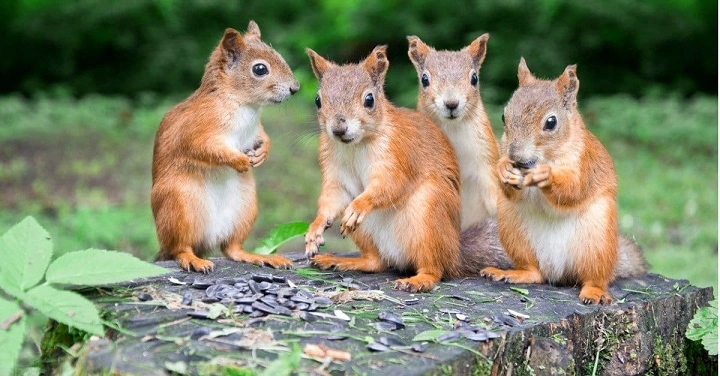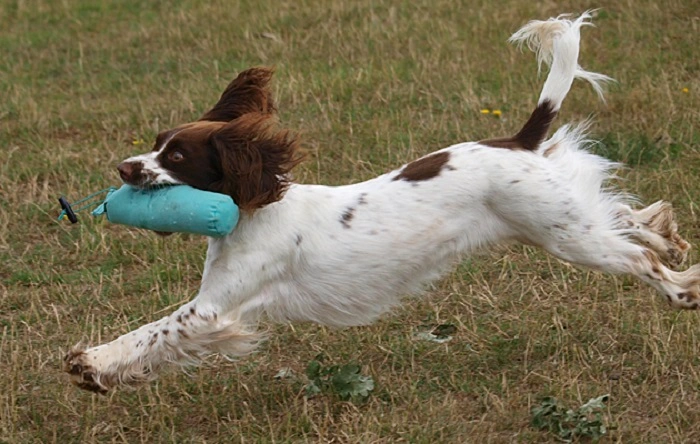You see them zip across the lawn like rays of light. One takes off. Another answer. A third whorls up the oak like a corkscrew. And you wonder—what do you call a group of squirrels? The first thing that occurs is a kind and a sort of old-fashioned type: a scurry or a dray. One is a verb that describes their movement. The second, a dwelling. Combined, they give us words for a tiny circus among the trees.
Quick Response: Collective Noun for Squirrels
The terms are a scurry of squirrels or a dray of squirrels.
Scurry is active—just right for all the zigzags and jerk stops.
Dray is softer; it is also used for their green dwelling, the tidy bundle stowed away up in trees.
Choose one to employ on a daily basis if necessary. Employ scurry. It’s energetic. It’s hip. It’s what you see.
Why “Scurry” Is Such a Good Word

Observe three squirrels at once. They do not stroll. They scurry. A run to the feeder. A pause. A bound onto a trash can lid. That fluttery fearfulness is built into the word itself. Puffing. Short. Slightly breathy to say.
Writers adore it since it takes but a single syllable to get motion across. Teachers adore it since children can learn it. And if you’ve ever recorded squirrels on your phone at 2x speed, you’ll recognize the name isn’t only adorable—it’s accurate.
What Is a “Dray”?
A dray (or drey) is a squirrel home—sticks in the middle, topped with leaves, grass-lined, and typically topped off with a soft cushioning of ripped bark. A football-sized package that is snug where two branches form a circle. Cozy in winter. Hidden in summer green.
Later on, dray also became an at-group noun name applied to the squirrels themselves. Not as often as scurry, maybe. But beautiful. It ties. Haven. Home. Family. Where scurry is the path, dray is the fireside.
Do Squirrels Actually Travel in Groups?
Tree squirrels are typically solitary creatures. They mark territory, cache by themselves, and prefer space to themselves—especially around their favorite trees. That’s why a “scurry” is so delightful to see. It typically takes place when:
- Food is plentiful (downed acorns, full feeders)
- Mating and curiosity time are increased
- Refuge attracts a variety of animals to the same line of trees
Ground squirrels, by contrast, can be more social. They dig colonies. They keep an eye on the sky in shifts. If you’ve ever seen an open field peppered with little sentries, you’ve seen their version of community. For them, “colony” is also used informally—though scurry and dray remain the fun, memorable terms.
Seasonal Scenes: When “Scurries” Sparkle
Autumn is scurry time in earnest. Nuts drop. Instinct hums. Squirrels race around, burying, unburying, reburying—tiny logistic specialists of the leaf-litter. Winter caps their world with drays, especially after blizzards. Spring is repair time, love time, and delicate new growth for nest lining.
Summer? Park-day drama—tail flips, branch-to-branch racing, and play chases looking like tag with a burst of aerobic endurance.
Species Snapshots: Tree, Ground, and Flying Squirrels
- Tree squirrels (fox squirrels or gray squirrels, for example): agile climbers, frequent home visitors, usually solitary except when the food bonanza brings in a messy crowd.
- Ground squirrels: experts of underground life; social clusters may be larger and less frantic.
- Flying squirrels: night shift—trunk gliding along imperceptible webs of skin. If by sheer luck you happen to spot a group in the evening, run with them and bask in the enchantment.
How to Use the Words in a Sentence
- “On the trail we saw a scurry of squirrels jumping from pines.”
- “A dray of squirrels roosted in at the old maple at the back of our porch.”
- “The class laughed as a scurry plundered the bird feeder like little ninjas.”
Common Mix-Ups (And How to Avoid Them)
- “Crow murder of squirrels?” No—crows.
- “Squirrely herd?” Possible, technically, but not the conventional or poetic choice.
- “Nest or group?” A dray is both the nest and, extension-wise, the group. Context quickly clears up any confusion.
Why It Matters (Beyond Trivia Night)
Words bring focus. If you have a word for a squirrel town, you notice more. You glance up more. You hear the leaves differently. Language makes the ordinary become ritual. A child points and cries, “A scurry!”—and the stroll is a field trip.
Origins and Etymology—Light and Handy
Scurry likely imitates the sound and motion of fast scurrying. It’s onomatopoeic in purpose, if not in precise etymology: fast, light, busy.
Dray comes from old words for carts and bearers, ultimately to nests—baskets of life, if you please. The extension is sound reasoning: something that bears and carries.
Mnemonic Tricks to Remember
- Scurry = scurrying. Repeat it once. Observe them scurrying. It persists.
- Dray = “stay.” That’s the nest. Where they stay warm.
Teaching with a Scurry (Classroom Ideas)
- Vocabulary bell ringer: Play a 10-second squirrel video. Ask, “Which word fits?” Students vote scurry or dray—then describe why.
- Nature journaling: Have students tally behaviors—run, jump, forage, pause—and write one sentence using the collective noun.
- Art prompt: Draw a dray. What materials? Use both words correctly in two sentences.
Writer’s Corner: Adding Color to Nature Descriptions
Try substituting flat words with more evocative ones:
- Replace “some squirrels ran” with “a scurry of squirrels rippled along the fence line.”
- Replace “their nest” with “a weather-proof dray lined with spring grass.”
Small changes, huge scenes.
Social Posts You Can Swipe
- “Catched a scurry of squirrels parkouring. Monday vibes.”
- “Cozy dray caught in the elm—vacancy: 0.”
- “Me and a scurry fighting over who this picnic belongs to.”
Where You’re Most Likely to Spot a Scurry
- Urban parks with large trees and picnickery people
- College campus (generous picnickers, many oaks)
- Suburban developments with acorn-thick plantings
- Trail edges where safety meets food—berries, nuts, defensive brush
Also Read: Proven Methods to Grow Website Authority with Effective Link Building
Behavior Cues: Play or Defense?
- Play chases are loops and relaxed. Spirals. Stopping. Head tilting.
- Territorial battles are more sharp-pointed—tail flicks, bracing to stop running, irate calling.
- Dangers call produce a burst of stillness, then a scramble to trunks and out of the ground. If you ever have a whole scramble bring to a halt, then glance upward. Hawks instruct in silence.
A Little Guide to Tail Talk
That lovely big fuzzy tail? It’s a flag, a blanket, a rudder.
- Flick-flick: alarm or annoyance
- Umbrella curl: rain shelter and warmth blanket
- Counterbalance: the tail performs those bold leaps you gasp at
Other Interesting Collective Nouns (Because They’re Amusing)
A murmuration of starlings.
A parliament of owls.
A tower of giraffes.
A prickle of porcupines.
A confusion of wildebeest (in your head for a moment, in any case).
English loves poetry when you don’t know. Scurry and dray are ideal indoors.
Quick Quiz (Answer Out Loud)
- You’ve got five squirrels in the garden. What have you got? A scurry.
- You notice a leafy nest in the maple tree. What is it? A dray.
- You share your video of squirrels running back and forth in front of a bench. Best vocabulary? Scurry.
Practical Tip for Nature Lovers
If you have bird feeders, suspend them off windows and give squirrels a safer spot to land. It reduces collision and turf combat. You’ll have more “scurry theater,” less broken hearts, and a lot less thudding on the glass.
Why Kids Enjoy This Question
It is as if a secret door to words. They ask for what a group of squirrels is called, and words become treasure. They will try other animals too and discover a universe where to name is to watch. That discipline—of attention, of care—is magnified to perfection.
FAQs About Squirrelly Groups
1) What is the most common name for a group of squirrels?
Scurry occurs most often, especially if the squirrels are busy and moving themselves as a group.
2) What is “dray”—group or nest?
Both. A dray is primarily the nest. It is also used to refer to a group of squirrels, especially in and around the nest.
3) Are squirrels social enough to be found in great groups?
Tree squirrels are alone, so they are not seen in bunches. Ground squirrels do live in colonies, however, so there are groups of them.
4) Do “scurry” apply to flying squirrels too?
Yes. If you do get to observe plenty of them gliding or foraging in bunches, scurry is a proper collective noun.
5) Do I present both to my class first—scurry or dry?
Start with scurry. It’s evocative and easy to relate with behavior. Secondarily, add dray to link language with habitat.
Final Thoughts
Language redescribes the world. The moment you know what to call a herd of squirrels, the park has been remade. Trees are full of stories. Leaves full of secrets. A branch quivers, and there they are—a flash away to winter. A dray sleeping in the lee of the wind. Two small words. One searing window on the everyday magic that’s just beyond your door.


